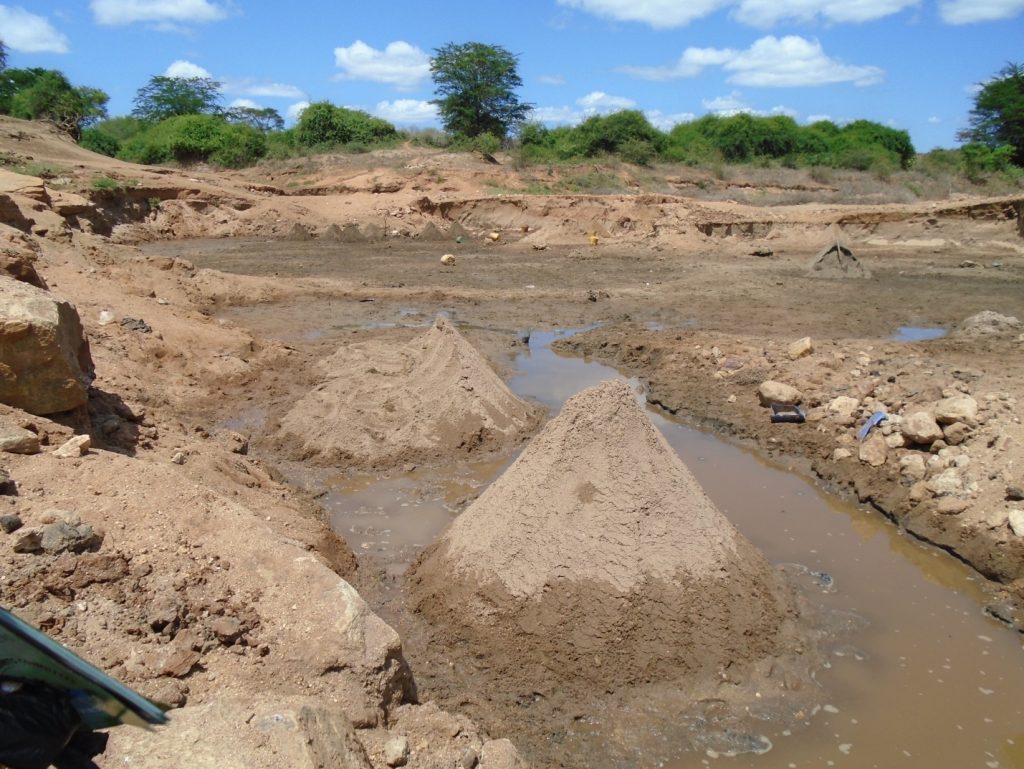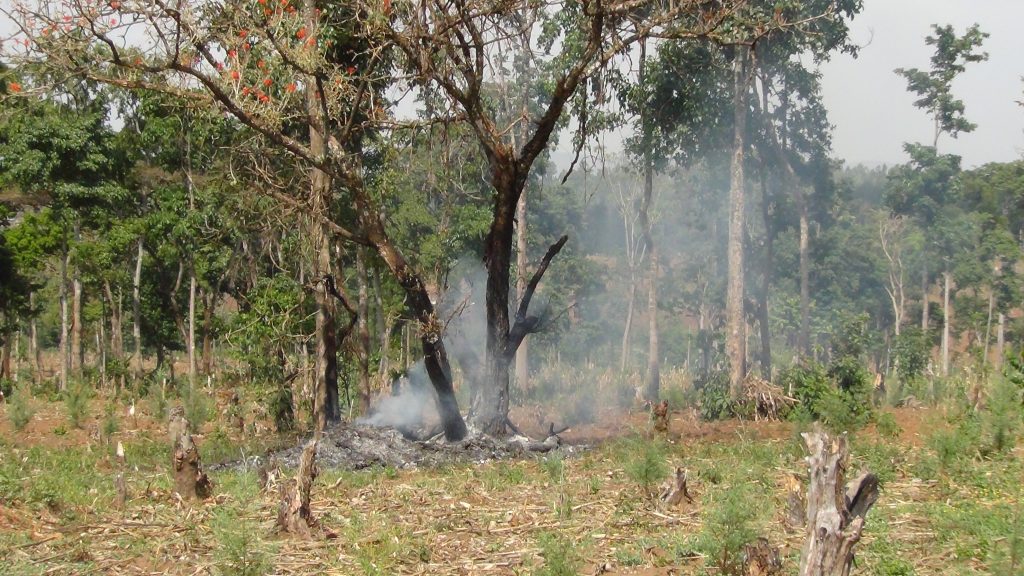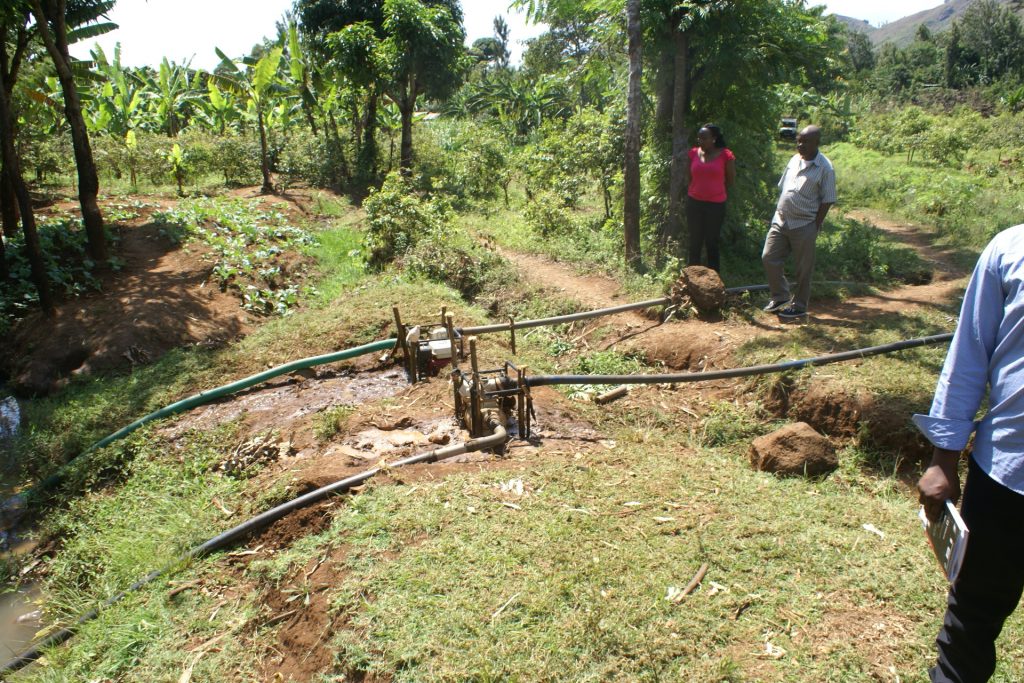The following complaints investigated by NECC are hereby highlighted in order to draw attention to the line ministries and NEMA on the magnitude of environmental degradation countrywide, which may even have international ramifications, e.g. the sewerage problem in Mombasa vis a vis tourism, the country’s top foreign exchange earner.
harvesting
Sand harvesting along Kerio River in Elgeyo Marakwet
The complaint alleged that there were sand harvesting activities that had interfered with the ability of the sand in the river to contain the water along Kerio River, which had become seasonal as a result of degradation caused by rampant sand harvesting. This complaint highlighted the absence of harmonization of environmental laws and coordination among the different agencies dealing with the particular aspects of the environment hampers the seamless interpretation and implementation of the law in environmental management.
The government should provide a unified legal framework that will address the short-comings amongst the environmental agencies, which includes;
- Licensing
- Enforcement
- Management
- Coordination
- Institutional weaknesses
AIR
Air pollution
Burning of waste is worsening air pollution by pumping more emissions into the atmosphere. Garbage burned in such fires normally emits gases like carbon monoxide, mercury as well as carbon dioxide – the most common greenhouse gas produced by human activity that can substantially affect human health and climate change.
Incineration of medical waste has also caused alarms due to the health hazards associated with the smoke. Items common to medical waste that may contain dioxins and furans are blood bags and fluid (IV) bags. Smaller amounts of dioxins are present in bleached paper products including facial tissue, toilet tissue, paper towels, and disposable diapers. Instead of recycling them, the medical waste incinerator needlessly burns plastic and paper products – the very things that when burned form dioxins and furans. Dioxins formed during incineration are released into the air and travel long distances via air currents, contaminating fields and crops. Cattle and other livestock eat soil contaminated with dioxin which enters their tissues and then people consume the contaminated meat and dairy products. Once dioxins enter the human body they are absorbed by fat tissue where they bio-accumulate. In the environment, dioxins tend to accumulate in the food chain. Birds are highly susceptible to poisoning because of their eating habits close to the ground. This accumulation has been linked with the increased cases of cancer in the recent past.
Despite waste burning causing such harmful health and environmental effects, it rarely attracts much attention. The sad reality is, emissions from burning waste in open fires often go unreported to environmental agencies and are left out of national inventories of air pollution. As a result, there are currently no resilient policies regulating the act.
Examples of outstanding cases include;
- The emissions from the Bomu Hospital incinerator were linked to health hazards in the neighbourhood.
- Most dumpsites for example Dandora, Kachok and Kibarani, have a tendency of burning waste which emits a choking smell that has substantially affected human health and climate change, to say the least.
Noise
Noise Pollution
With increased urbanization and industrialization the aspect of noise pollution can no longer be ignored. Noise from entertainment spots, automobiles, religious setups and heavy machinery has become a nuisance to nearby residents. Lack of adherence to the regulations setup by the Authority is detrimental to the enjoyment of peace and quiet.
Citing a few examples below:
- Mtwapa Stakeholders Forum complained of excessive noise due to loud music played at night by the clubs affecting area residents
- Residents of Nairobi west lodged a complaint against The House of Grace Church for carrying night vigil as they conduct their pastoral activities which resulted in noise pollution
- Residents of Kilungu Lane complained of noise pollution caused by barking dogs belonging to Radar Security Limited
Deforestation
Deforestation
Over the period, NECC has been able to carry out investigations into 17 cases of deforestation. There is massive destruction of forests due to illegal logging, charcoal burning, woodfuel demand, demand for construction materials and clearing of forests to pave way for projects. A few outstanding cases include:
- In Taita Taveta County, there is clearing of forest land for the proposed relocation of Voi Girls’ Education Centre to pave way for the construction of he Standard Gauge Railway (SGR).
- In Kwale County there is indiscriminate cutting down of trees to meet the demand for construction materials and charcoal burning. The mangrooves are threatened by over exploitation, pollution, salt manufacture and siltation.
- In Dakatcha woodlands, there’s irregular issuance of permits to allow charcoal burning.
- Inadequate capaciy in personel and equipment for effective forest management is leading to the encroachment of gazetted forests. Deforestation is likely to lead to loss of biodivesity and destruction of water catchment areas and threatening the water towers.
Licensing
EIA & EIA Licensing
E.I.A is critical in the examination of the effects of a project on the environment. An E.I.A identifies both negative and positive impacts of any development activity or project, how it affects people, their property and the environment at large. If a comprehensive E.I.A is carried out then the safety of the environment can be properly managed at all stages of a project –planning, design, construction, operation, monitoring and evaluation as well as decommissioning.
NECC has investigated cases involving commencement of projects without conducting EIA. A case scenario is that of the Northern Collector Water Tunnel in Murang’a County. The Athi River Water Service Board (AWSB) commenced the construction of the Northern Collector Water Tunnel without a requisite E.I.A license. There are cases where an EIA was conducted without adequate public participation in the process.
The case of Riverside Gardens Residents Association against Globe Developers Limited; there was objection to a proposed development due to violation of zoning regulations and inadequate public participation during the EIA process. There are also cases where project proponents failed to stick to the conditions of the EIA license.
A good example is the case of Syracuse Wildlife House and Research Center against NEMA, Kajiado County where there was construction of a storey building without following the requisite EIA process.
water
Water Pollution
This is the contamination of water bodies of lakes,rivers,oceans as well as acquifers and ground water. It occurs when pollutants are discharged directly or indirectly into water bodies without adequate treatment to remove the harmful compounds. The main sources of water pollution are industrial discharge,sewage,seepage from waste sites and illegal solid and liquid waste disposals. Millions of people are vulnerable to health risks as a result of consuming contaminated water or using the same to irrigate crops. Contamination also leads to death of aquatic life,disruption of food chains,destruction of ecosystems,water crisis etc.
NECC has investigated a huge chunk of cases on water pollution,including:
- Mr. Joseph Kigutuki complained to NECC against the Meru County Government on to the location of a dumpsite within the forest whereby waste is washed down into a water source posing a health risk to the area residents of Nkunga Location.
- NECC received a complaint regarding environmental degradation as result of disposal of untreated sewage from Embu Town and Mwea Irrigation Scheme into Rivers Rupingazi and Nyamindi
Solid Waste
Solid Waste Management
Solid waste management in Kenya has become one of the biggest challenges that Government institutions tasked with the same are grappling with. Political interference, poor servicing of municipal solid waste collection vehicles, inadequate funding and the poor state of infrastructure are some of the challenges faced in waste management. Migration from the rural areas to the urban especially one prime city Nairobi has resulted in an exponential increase in waste generation and unplanned settlements. With rapid urbanization, the current amount (about 4 million tons/year) generated is expected to double by 2030.
Poor waste management impacts the health of the population as well as the environment. Leachate flowing from waste dumps and disposal sites can cause serious pollution of surface and underground water; flies and mosquitoes breed in the constituents of solid waste and are vectors that spread diseases; dangerous items such as broken glass, razor blades, hypodermic needles and other healthcare wastes pose risk of injury and poisoning; burning wastes in disposal sites cause air pollution, affect climate change through the increase of greenhouse gases and affect human health by causing respiratory diseases
Poor waste management interferes with every Kenyan’s right to a clean and healthy environment as provided for in Article 42 of the constitution. 27% of the total complaints investigated by NECC in 2017 are on solid waste management.
The extent and nature of the solid waste management problem can be summarized as follows to mention but a few;
-
The proportion of the solid waste generated vis -a -vis that which is collected, is very low
-
There is widespread indiscriminate dumping in illegal dumpsites and waste collectors litter the city/towns with unusable waste materials without control
-
There is only one official dumpsite in most towns and the dumpsites are normally controlled by waste cartels who charge waste collectors to access them. As a result of these disposal problems, almost all enterprises tend to use uncontrolled and unhygienic landfills as the predominant mode of disposal. To cut costs, many generators of solid wastes have now taken to combustion at the site, which causes air pollution problems. The bulk of these wastes contain plastics, which when burnt generate carcinogenic vinyl chloride monomers and dioxins. The generators and private waste collection firms, again to avoid costs, dump in illegal places since an effective monitoring system lacks
-
Solid wastes in the city and towns are not segregated. Consequently, the dumpsites are littered with all types of wastes from hospital wastes, manufacturing/industry wastes, paper and biodegradable materials.
In response to the consistently increasing challenge of solid waste management, there were several policy frameworks formulated and enacted to address it. Solid waste management and its effects cut across various sectors and stakeholders. Therefore, to effectively address the challenge of solid waste management, policy statement integration among and within the various sectors and stakeholders is essential.
Summary of Wastes genereated, collected and recovery status in major towns ( as per The National Solid Waste Management Strategy 2015)
| Name of town | Estimated waste generated (tons/day) | % of waste generated | % of waste recovery | Uncollected waste (%) |
| Nairobi | 2400 | 80 | 45 | 20 |
| Thika | 140 | 60 | 30 | 40 |
| Mombasa | 2200 | 65 | 40 | 35 |
| Eldoret | 600 | 55 | 15 | 45 |
| Nakuru | 250 | 45 | 18 | 37 |
Way Forward
The Government should;
-
Strengthen the capacity of environmental institutions at both the national and county levels so as to make them more effective in ensuring compliance and enforcement.
-
Ensure that county governments monitor development in their jurisdictions and that the intensity of housing development does not exceed the capacity of the existing sewerage system. Where such development is to exceed the sewerage capacity, plans should be made to upgrade the sewerage capacity first.
-
Ensure that there is strict enforcement of laws and regulations relating to waste management in the country in the bid to promote a clean and healthy environment for all.
-
Implement the existing Solid Waste Management Strategy and strictly enforce the legal framework of Solid Waste Management.
-
Ensure that through relevant lead agencies and other institutions, Master plans are designed and implemented for each urban area to ensure that development is commensurate to the provision of water and sewerage services.
-
Ensure the existing legal framework relating to waste management is strictly adhered to
-
Promote the use of economic incentives to manage waste and implement the national solid waste management strategy. It should also promote establishment of facilities for cleaner production, waste recovery, recycling and re-use
-
Ensure that developments in the country are commensurate to the sewerage infrastructure as well as other sanitation services
-
Formulate and enact a policy on public participation with clear guidelines on when dissenting opinions are considered in making decisions relating to environmental management.
-
Fast-track the implementation of the National Solid Waste Management Strategy across the country.
-
Fully implement the hazardous waste regulations.
-
Ensure that environmental agencies tasked with enforcing the law are adequately facilitated to carry out their mandate.
-
Ensure it put up and operate effective sewerage infrastructure in all towns.
-
Ensure development of appropriate water and sanitation and infrastructure for waste management. It should also strengthen the capacity of environmental institutions at county and national levels so as to make them more effective in ensuring enforcement and compliance.



